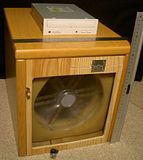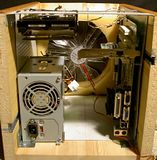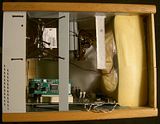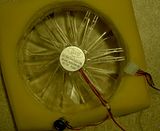And why? My guess is because they blow on the motherboard, but not past it. On the side of the graphics card, not past it (and not through the fins). On the top of the CPU tower cooler, again not through the fins. Overall, they tend to simply pressurize the case, partly disrupting "normal" front-to-back airflow. Turning/removing the front fan will create a T-junction airflow path: intake on the side, exhaust at the front and back. This isn't necessarily bad, but in such a case you are still likely to need spot cooling on CPU and graphics card.
So what did I do? I opted for the simplest possible case design: straight front-to-back airflow. High airflow, minimal turbulence, low noise. Positive pressure coupled with a dust filter. Indeed, this seemed like a good idea (in theory). A MATX board, 24cm wide, should be the perfect size for two 12cm fans (or possibly 14cm). But I figured a single 22cm might work as well.
Now, to get the most benefit of the relatively low-pressure low-velocity airflow, large heatsinks with wide fin spacing should be used. For the CPU that means Ninja or Mini Ninja. For the graphics card, well... an Accelero S1 will have to do. If it turns out the airflow through the S1 fins is not enough, some ducting or mounting an extra fan should fix it.
Ok, time to turn theory into practice. Make a sketch and get to work. Unfortunately it turned out that I'm not a very handy person, so it took quite a long time to make a rather ugly case.
 The front of the case. Size: 300x325x400 mm (WxHxD) The dust filter may not be noticable, but it is there. At the bottom, the included rheobus fan controller. At the top, a flip panel that covers the optical. Beside it a 3.5" fan controller may be placed if I need one. At the left, the power button literally sticks out.
The front of the case. Size: 300x325x400 mm (WxHxD) The dust filter may not be noticable, but it is there. At the bottom, the included rheobus fan controller. At the top, a flip panel that covers the optical. Beside it a 3.5" fan controller may be placed if I need one. At the left, the power button literally sticks out.  Backside of the case. Scrap hardware, but should give an idea on how the airflow goes. You have to picture a Mini Ninja on the CPU, and above it a graphics card with an S1 mounted. The PSU covers about 20% of the area, the Mini Ninja about the same. The HDD gets less than 10%. The rest of the airflow goes to the graphics card, the motherboard, and to waste. Hopefully in that order.
Backside of the case. Scrap hardware, but should give an idea on how the airflow goes. You have to picture a Mini Ninja on the CPU, and above it a graphics card with an S1 mounted. The PSU covers about 20% of the area, the Mini Ninja about the same. The HDD gets less than 10%. The rest of the airflow goes to the graphics card, the motherboard, and to waste. Hopefully in that order. Top-down view. Notice how short the mb is compared to the case (though 40cm isn't that long for a case). The real mb will probably be shorter still (<20cm). The foam holding the fan takes quite some space, but not enough to be a problem. Actually I'd prefer to move it a bit into the case to get more distance between the filter and the fan. PSU can be moved back if needed. The crossing plates at the back holds a suspended harddrive. Maybe I will try some other solution for that. The plate near the front will hold an optical drive in place.
Top-down view. Notice how short the mb is compared to the case (though 40cm isn't that long for a case). The real mb will probably be shorter still (<20cm). The foam holding the fan takes quite some space, but not enough to be a problem. Actually I'd prefer to move it a bit into the case to get more distance between the filter and the fan. PSU can be moved back if needed. The crossing plates at the back holds a suspended harddrive. Maybe I will try some other solution for that. The plate near the front will hold an optical drive in place. The Bzerk fan. I recall someone identified it as the fan from the original Xclio, but i'm not sure. It's not a very good fan, then again not that bad either, and replacement 22cm fans are quite hard to find. There is a high-pitched "ringing" noise to it, which decreases slowly with speed, and remains to some extent even at low rpms when the regular hum and whoosh sounds are gone. At first I thought this was the ball bearing ringing, but it might as well be the motor whining.
The Bzerk fan. I recall someone identified it as the fan from the original Xclio, but i'm not sure. It's not a very good fan, then again not that bad either, and replacement 22cm fans are quite hard to find. There is a high-pitched "ringing" noise to it, which decreases slowly with speed, and remains to some extent even at low rpms when the regular hum and whoosh sounds are gone. At first I thought this was the ball bearing ringing, but it might as well be the motor whining. Speaking of which, which PSU should I go with? Yes, a subject never discussed before.
Skimming through the shop I'm considering, these stand out (in price order):
Mushkin EP 400w - half-modular (no major benefit), 2 pcie, but not very efficient (haven't found more than 2 reviews though, not enough)
Be Quiet L7 350w - efficient, possibly silent (where are the reviews?)
Seasonic S12II 330W - efficient, should be quiet below 200W, lots of cables though
Corsair CX400W - should be good upto 250W, but again lots of cables
Xigmatek 400W - nah, hardly better than Corsair
SilverPower 400w - hardly better than Corsair
Arctic Cooling 500W - 2pcie, and this is interesting for the front-to-back airflow alone, but 8 cables may be too much to handle
Tagan Superrock, Corsair VX, yada yada...
Enermax LibertyECO - finally a modular, but nothing special, and costly
Ah well, better stop now, as I'm probably not willing to pay more.
Alrighty then... comments? Suggestions? Please?
